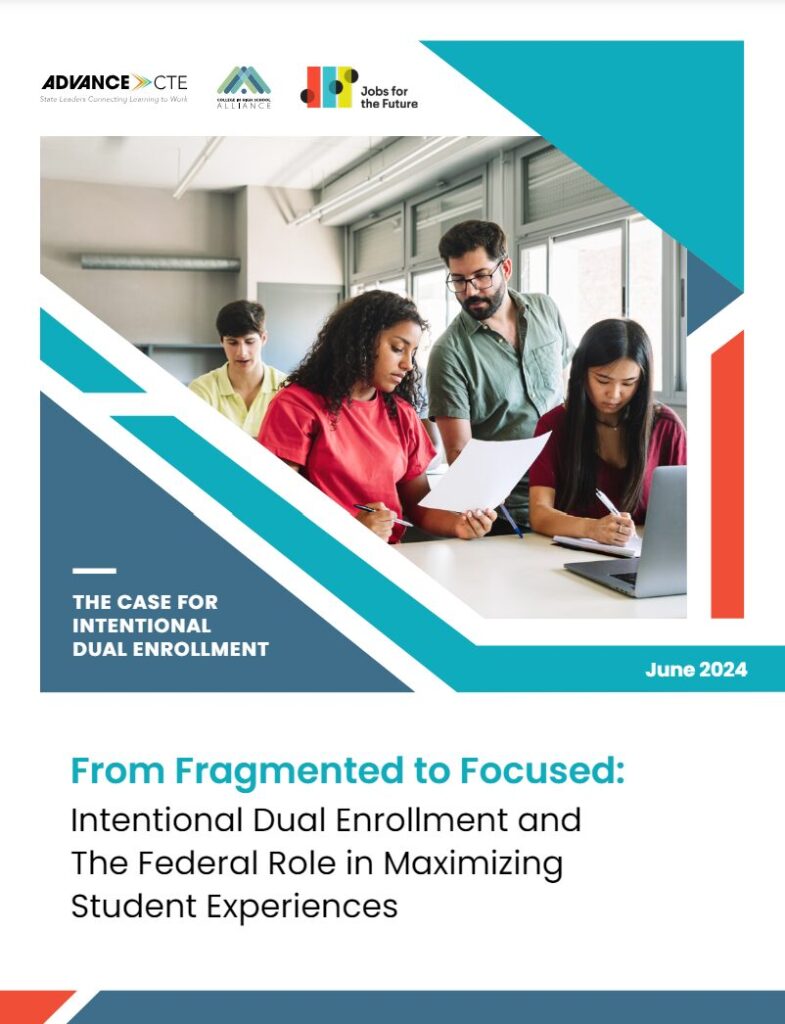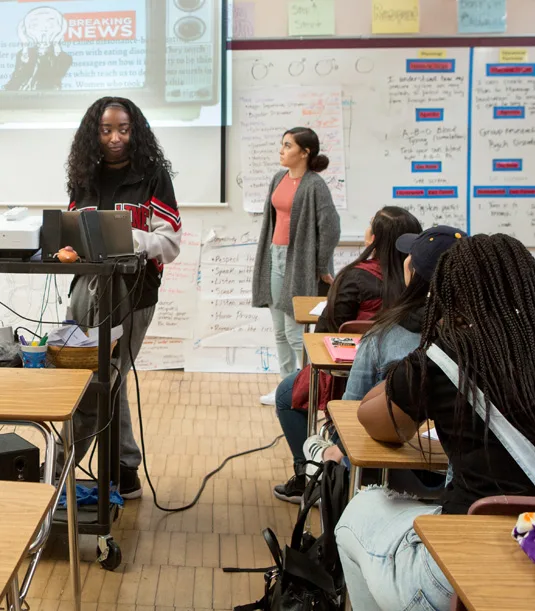From Fragmented to Focused: Intentional Dual Enrollment and the Federal Role in Maximizing Student Experiences
Making Dual Enrollment Work Better for Every Student
June 2024
Across the country, more high school students than ever are earning college credit through dual enrollment, concurrent enrollment, and early college high school programs. These opportunities are proven to improve college access, completion, and career outcomes — but not all programs are designed to help students fully benefit.
From Fragmented to Focused, a joint report from Advance CTE, the College in High School Alliance (CHSA), and Jobs for the Future (JFF), makes the case for intentional dual enrollment — programs that are structured, equitable, and connected to clear college and career pathways. It also outlines how federal policy can help scale these programs nationwide to ensure every student experiences the full benefits of college in high school opportunities.
The Case for Intentional Dual Enrollment
Simply giving high school students access to college courses isn’t enough. To truly prepare learners for college and career success, dual enrollment programs must be intentionally designed — integrating curriculum across secondary and postsecondary systems, providing strong advising and counseling, and eliminating cost barriers for low-income students.
Intentional dual enrollment:
-
Aligns coursework with structured college and career pathways
-
Provides meaningful advising and navigational supports
-
Connects to local workforce needs and real-world opportunities
-
Ensures equitable access for all learners, especially those historically underserved
These design principles form the foundation for the next phase of national dual enrollment policy, building on CHSA’s 2023 report, The Next Phase of Dual Enrollment Policy: A Vision for the Field.
Federal Leadership Is Key
While states have made major progress, dual enrollment policy remains a patchwork of disconnected systems. Federal leadership can bring coherence, scale, and equity to this growing field by providing a clear national vision and aligning funding streams.
The report calls for six key federal actions to move from fragmented to focused:
-
Raise National Expectations – Update federal definitions of dual enrollment and prioritize intentional models in federal grantmaking.
-
Improve Data Collection – Track both participation and success, aligning accountability systems across ESSA, Perkins V, HEA, and WIOA.
-
Integrate Career Navigation – Create national frameworks and tools for advising and career exploration.
-
Fund Intentional Dual Enrollment – Support programs that provide structured pathways and expand Pell Grant eligibility for dual enrollment students.
-
Improve Accountability Incentives – Encourage states to embed quality and intentionality in CTE and postsecondary metrics.
-
Create a Pathways Ecosystem – Align federal youth, education, and workforce programs under a cohesive national strategy.
Promising State Examples
-
North Carolina’s College and Career Promise (CCP): Consolidated all dual enrollment programs into one statewide system, connecting coursework directly to CTE pathways and postsecondary credentials.
-
Indiana College Core: Offers a 30-credit-hour transferable block of college coursework available in 200+ high schools, with a goal of statewide availability by 2025.
These examples show how state innovation can lead, but federal action is needed to ensure national consistency and equity.
Why It Matters
Dual enrollment has become one of the fastest-growing strategies for college and career readiness, with participation exceeding 40% of high school students in some states. Yet, quality and access vary widely. Without stronger national coordination and investment, many programs will continue to offer “random acts of dual enrollment” — disconnected courses that don’t lead to meaningful credentials or career outcomes.
Intentional dual enrollment offers a path forward — helping students earn credits that count, explore careers with purpose, and transition seamlessly into college and the workforce.
Download the Report

Discover how federal policy can drive the next era of dual enrollment, ensuring every student benefits from structured, equitable, and high-impact college in high school experiences.
About the Partners
This resource was developed as a result of multiple convenings facilitated by Bellwether in 2023 with organizations from across the United States dedicated to equity, education, and career pathways focused on innovative policy solutions for issues in the field today. The publication was written in partnership with JFF and Advance CTE, with the generous support of The Bill & Melinda Gates Foundation and the Joyce Foundation.
Access the paper
From Fragmented to Focused: Intentional Dual Enrollment and
The Federal Role in Maximizing Student Experiences


